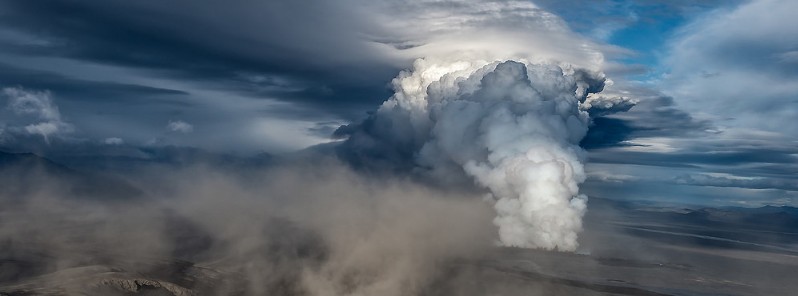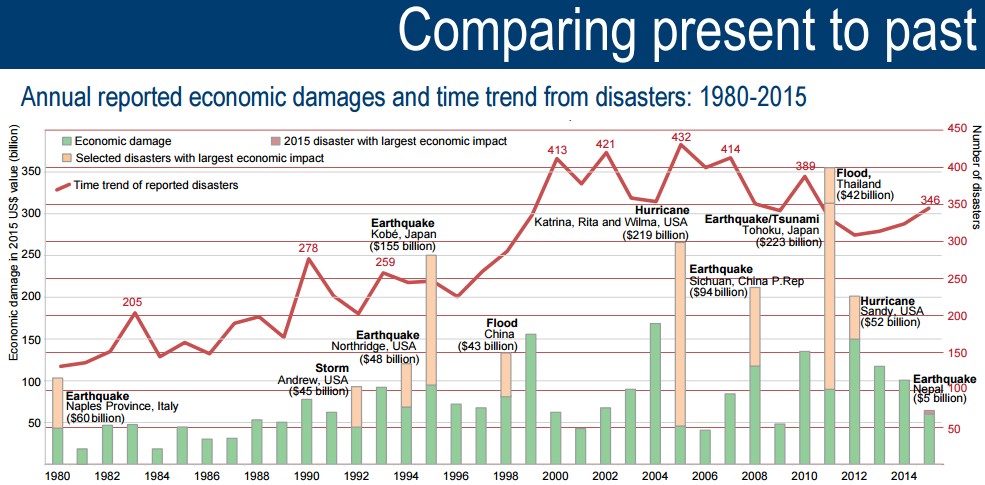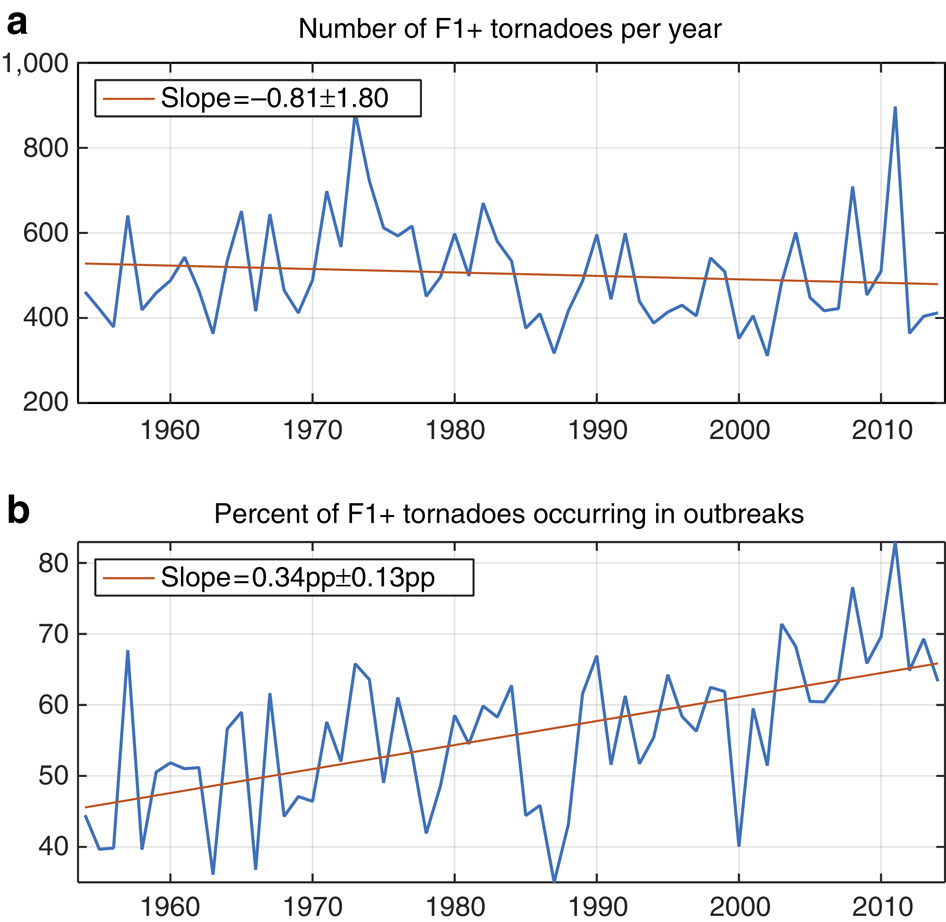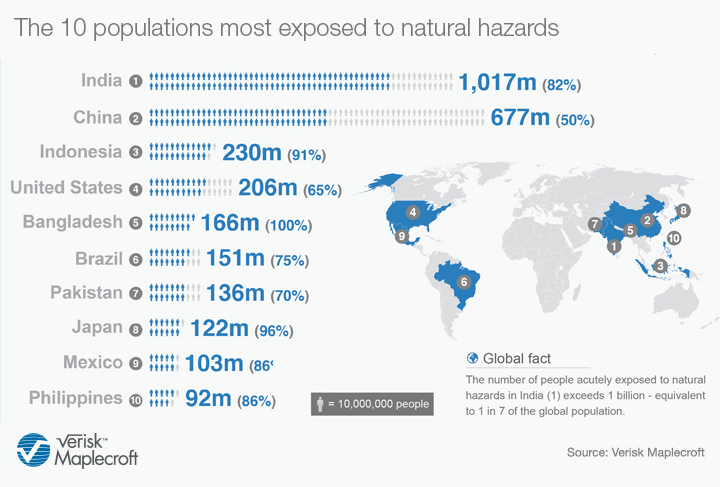The world is unprepared for impending natural disasters

For a long time, preppers and survivalists were ridiculed and called lunatics who just want the world to come to an end. However, as our planet entered a realm in which major natural disasters became a norm and officials finally admitted the world is heading into an uncharted territory, it became clear that preppers were actually just better-informed individuals.
No matter what the cause might be, natural disasters are occurring at an increased rate and, judging by rare official warnings, it will only get worse.
For example… Head of the UN Office for Disaster Risk Reduction (UNISDR), Dr. Robert Glasser, warned recently that world's failure to prepare for natural disasters will have 'inconceivably bad' consequences as climate change fuels a huge increase in catastrophic droughts and floods and the humanitarian crises that follow.
"With the world already “falling short” in its response to humanitarian emergencies, things would only get worse as climate change adds to the pressure," Glasser said.
“If you see that we’re already spending huge amounts of money and are unable to meet the humanitarian need – and then you overlay that with not just population growth, but you put climate change on top of that, where we’re seeing an increase in the frequency and severity of natural disasters, and the knock-on effects with respect to food security and conflict and new viruses like the Zika virus or whatever – you realise that the only way we’re going to be able to deal with these trends is by getting out ahead of them and focusing on reducing disaster risk.”
Failure to plan properly by factoring in the effects of climate change, he added, would result in a steep rise in the vulnerability of those people already most exposed to natural hazards.
He also predicted a rise in the number of simultaneous disasters.
“As the odds of any one event go up, the odds of two happening at the same time are more likely. We’ll see much more examples of cascading crises, where one event triggers another event, which triggers another event."

Annual reported economic damages and time trend from disasters: 1980 – 2015. Source: UNISDR
Since the beginning of the 20th century, natural disasters such as earthquakes, floods, storms, bush-fires and volcanoes caused over 8 million deaths, according to CATDAT database that utilized data from more than 35 000 natural disasters that occurred since 1900.
About one-third of economic losses between 1900 and 2015 have been brought on by flood events, while at the same time, earthquakes have caused 26% and storms 19% of the losses. At the same time, volcanic eruptions were responsible for about 1% of losses.
.jpg)
Economic Costs 1900 – 2015: Flood, Earthquake and Storm have caused the highest losses. Image credit: James Daniell, KIT
"Over the last 100+ years the economic losses via natural disasters, in absolute terms, have increased,“ said Dr. Daniell, risk engineer who composed the CATDAT. “Less developed nations are often more vulnerable towards catastrophes – that means relative to population and capital – and more deaths and higher economic losses are expected post-event."
This is mostly due to the building quality where building regulations and disaster codes are not adequately implemented. Also, the areas where people work, such as the coast of Bangladesh are highly populated, and the financial gains usually outweigh the potential disaster risks.
In other cases, such as the now infamous Indonesia's tsunami early-warning system, authorities just don't pay enough attention to looming disasters and don't invest enough to maintain equipment designed to save lives.
Numerous studies show that extreme rainfall events are rising globally. While before 1980, multi-decadal fluctuations in extreme rainfall events are explained by natural variability, scientists detected a clear upward trend in the past few decades towards more unprecedented daily rainfall events. A study from the Potsdam Institute for Climate Impact Research showed that extreme rainfall events are strongly increasing in the Balkans, even more than the globally observed rise.
If you live in the United States, you should be aware that a new research from Columbia University's School of Applied Science and Engineering shows the average number of tornadoes occurring during severe weather outbreaks is rising since 1954. The cause for this upward trend is still unknown, but the study also suggests the chances of such extreme weather outbreaks have risen. On the bright side, while the average number per outbreak has risen, the total number of tornadoes rated F/EF1 and higher each year hasn't increased.

Time series of counts and clustering of F1+ tornadoes 1954–2014 in the contiguous US. (a) Number of F1+ tornadoes per year. The slope of the least-squares regression indicates that the number of F1+ tornadoes per year declined by 0.81 per year on average from 1954 to 2014 inclusive. This rate of decline is not statistically significantly different from 0 (no change). (b) Annual percentage of F1+ tornadoes occurring in outbreaks. The slope of the least-squares regression indicates that the percentage of F1+ tornadoes per year that occurred as part of outbreaks increased by 0.34 percentage points (pp) per year on average from 1954 to 2014 inclusive. This increase is statistically significantly greater than 0. In both a and b, ± intervals are 95% confidence intervals. Credit: Michael K. Tippett & Joel E. Cohen / Nature Communications.
1.4 billion people in South Asia, 81% of the region’s population, are acutely exposed to at least one type of natural hazard and live in areas considered to have insufficient resources to cope with and rebound from an extreme event, according to research published by risk analysis and research company Verisk Maplecroft in March 2016.

Credit: Verisk Maplecroft
The data collected by Verisk Maplecroft identifies flooding as one of the most substantial risks to communities and business in South Asia. In India alone, 113 million people, or 9% of the population, are acutely exposed to flood hazard, with a further 76 million exposed in Bangladesh and 10 million in Pakistan. Indeed, heavy monsoon rain in November-December 2015 sparked record flooding in South India, which cost the country upwards of US$3 billion and displaced more than 100 000 people.
In its city-level analysis, Verisk Maplecroft flags the populations of three South Asian cities among the 10 most exposed globally. These include the major garment producer Dhaka in Bangladesh (ranked 5th most exposed) and the rapidly growing tech hubs of Kolkata (6) and Delhi (9) in India. Manila, Philippines (1), Tokyo, Japan (2), Jakarta, Indonesia (3), Dongguan, China (4), Osaka, Japan (7), Mexico City, Mexico (8) and Sao Paolo, Brazil (10) complete the list.
The top 3 safest countries in the world in terms of natural disasters seem to be Qatar, followed by Malta and Saudi Arabia, according to World Risk Report 2015.
Dr. Matthias Garschagen, scientific director of the World Risk Report, said large-scale disasters such as the earthquakes in Nepal and Haiti often act as stark reminders of fundamental development problems. But although international attention is quick to focus on huge disasters and lessons are often learned, Garschagen says the momentum is not always sustained.
And therein, he added, lies the challenge: “Every time there’s a mega disaster, there are lessons learned – or at least there’s a lot of attention in the scientific and political realm. The key question is always, how do you keep up the awareness after a couple of years?”
The truth is, most governments are not doing enough to protect lives of their citizens, and we should not rely on them. When push comes to shove, our dog-eat-dog world becomes even more evident.
Each of us needs to be prepared for the worst.
Featured image: Holuhraun eruption, Bardarbunga, Iceland 2014. Credit: Sparkle Motion

Scientist know full well the Earths poles are shifting and have known it for a long while. No way would they or anyone else know how to handle it, or prepare for it for that matter. So in comes the climate scammers such as Al Gore and his friends, including their bought and paid for minions. Billions and billions in their pockets. Forget the rest of mankind, they’re expendable, both their money and their lives. But all these selfish me me me scammers can do is grasp for straws, and my guess is that their efforts will all be for naught. Only the good, those close to God and nature will survive.